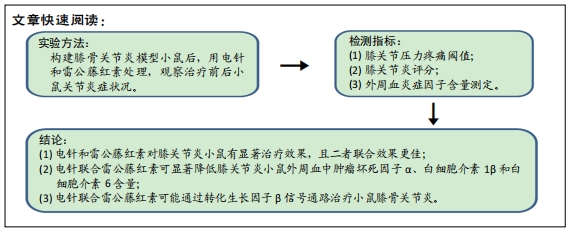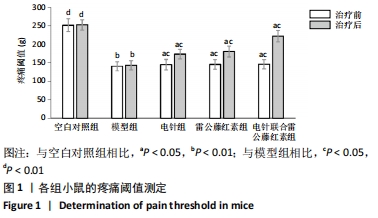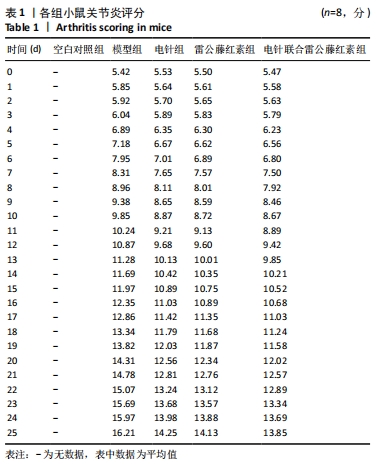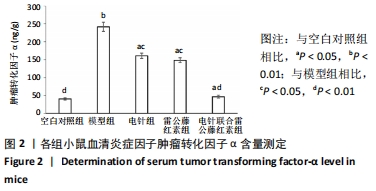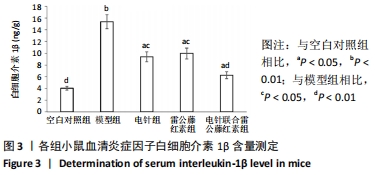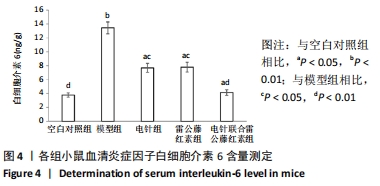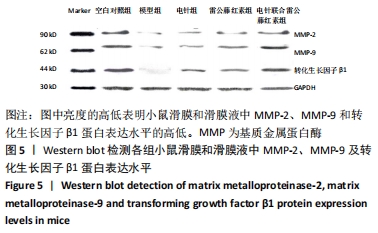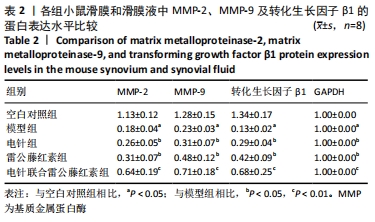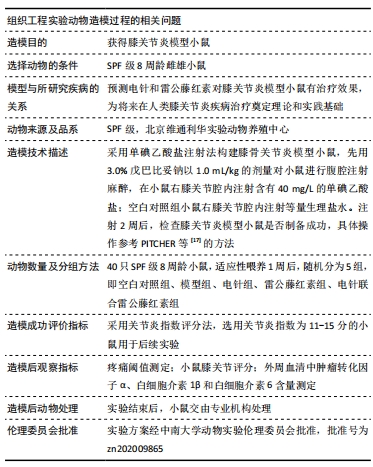[1] CHEN Y, YANG Y, WANG F, et al. Antiviral effect of baicalin phospholipid complex against duck hepatitis A virus type 1. Poult Sci. 2018;97(8): 2722-2732.
[2] ALAM J, JANTAN I, BUKHARI SNA. Rheumatoid arthritis: Recent advances on its etiology, role of cytokines and pharmacotherapy. Biomed Pharmacother. 2017; 92: 615-633.
[3] MATEEN S, ZAFAR A, MOIN S, et al. Understanding the role of cytokines in the pathogenesis of rheumatoid arthritis. Clin Chim Acta. 2016;455: 161-171.
[4] FISCHER BD, ADEYEMO A, O’LEARY ME, et al. Animal models of rheumatoid pain: experimental systems and insights. Arthritis Res Ther. 2017;19(1):146.
[5] BESSIS N, DECKER P, ASSIER E, et al. Arthritis models: usefulness and interpretation. Semin Immunopathol. 2017;39(4):469-486.
[6] 詹红生, 郑昱新. 成人膝关节滑膜炎诊断与临床疗效评价专家共识[J]. 中国中医骨伤科杂志,2016,24(1):1-3.
[7] 陈星, 欧会芝, 陈苑妮. 行湿汤联合医用臭氧治疗膝关节滑膜炎的临床研究[J]. 中国中医急症,2018,27(2):287-288,292.
[8] 许兴辉. 滑膜炎汤治疗湿热阻络证膝关节滑膜炎的临床研究[J]. 中国医药导报,2017,14(19):106-109.
[9] 林小东, 李华华. 关节腔臭氧注射配合中医辩证治疗创伤性膝关节滑膜炎45例临床观察[J]. 颈腰痛杂志,2014,35(6):481-482.
[10] 冯淑怡, 张志伟, 李志刚, 等. 滑膜炎颗粒对大耳白兔膝关节损伤保护作用的实验研究[J]. 国际中医中药杂志,2015,37(12):1096-1100.
[11] 曹方, 袁月, 宋柏林. 针灸治疗膝关节滑膜炎临床取穴配伍规律研究[J]. 中华中医药杂志,2018,33(5):2112-2115.
[12] 杨东红, 仲丛丹, 韩洋, 等. 透刺为主治疗膝关节滑膜炎[J]. 吉林中医药,2017,37(10):1073-1075.
[13] 许伟明, 张郭杰. 热敏灸辅助治疗膝关节滑膜炎的临床疗效及作用机制研究[J]. 中国针灸,2018,38(11):1163-1168.
[14] 刘英民, 赵雪竹. 针刀治疗膝关节创伤性滑膜炎40例疗效分析[J]. 海南医学,2015,26(1):109-111.
[15] 黄美州, 秦雪飞, 王泉巅, 等. 中药外敷治疗膝关节急性创伤性滑膜炎的临床研究[J]. 中国中医骨伤科杂志,2014,22(7):18-20.
[16] JAGPAL A, NAVARRO-MILLAN I. Cardiovascular co-morbidity in patients with rheumatoid arthritis: a narrative review of risk factors, cardiovascular risk assessment and treatment. BMC Rheumatol. 2018;2:10.
[17] PITCHER T, SOUSA-VALENTE J, MALCANGIO M. The Monoiodoacetate Model of Osteoarthritis Pain in the Mouse. J Vis Exp. 2016;111:53746.
[18] VOS T, FLAXMAN AD, NAGHAVI M, et al. Years lived with disability (YLDs) for 1160 sequelae of 289 diseases and injuries 1990-2010: A systematic analysis for the Global Burden of Disease Study 2010. Lancet. 2012; 380:2163-2196.
[19] YANG X, YANG J, ZOU H. Baicalin inhibits IL-17 mediated joint inflammation in murine adjuvant-induced arthritis. Clin Dev Immunol. 2013;2013:268065.
[20] KISHORE S, MATHER L, MAJITHIA V, et al. Rheumatoid vasculitis: a diminishing yet devvastating menace. Curr Rheumatol Rep. 2017; 19(7):39.
[21] TAYLOR SC, POSCH A. The design of a quantitative western blot experiment. Biomed Res Int. 2014;2014:361590.
[22] CAPLAZI P, BACA M, BARCK K, et al. Mouse models of rheumatoid arthritis. Vet Pathol. 2015;52(5):819-826.
[23] NOH K, KANG Y, NEPAL MR, et al. Role of intestinal microbiota in baicalin-induced drug interaction and its pharmacokinetics. Molecules. 2016;21(3):337.
[24] QU X, MEI J, YU Z, et al. Lenalidomide regulates osteocytes fate and related osteoclastogenesis via IL-1β/NF-kβ/RANKL signaling. Biochem Biophys Res Commun. 2018;501(2):547-555.
[25] 曹永飞, 贾鹏, 王长海. 滑膜炎颗粒口服联合中药外敷治疗急性创伤性膝关节滑膜炎临床研究[J]. 中国中医急症,2015,24(3):413-414,456.
[26] SAKAUE S, OKADA Y. Human genetics contributes to the understanding of disease pathophysiology and drug discovery. J Orthop Sci. 2017; 22(6):977-981.
[27] 章海凤, 陈树涛, 冒姣娜, 等. 热敏灸对膝骨性关节炎兔模型 IL-1β、TNF-α、MMP-13 的影响[J]. 中华中医药杂志,2018,33(9): 3913-3917.
[28] 刘建华, 赵海勇, 温芳, 等. 炎性细胞因子在膝骨关节炎中的表达及与高敏C反应蛋白和红细胞沉降率的相关性[J]. 天津医药, 2020,48(1):55-58.
[29] Mun CJ, Letzen JE, Nance S, et al. Sex differences in interleukin-6 responses over time following laboratory pain testing among patients with knee osteoarthritis. J Pain. 2020;21(5/6):731-741.
[30] 曹迪, 张亚密. 加味芍药甘草汤辅助治疗对癌性疼痛患者疼痛介质及炎性因子的影响[J]. 中国医药导报,2020,17(7):143-146.
[31] 袁定坤, 肖启贤. 硫酸氨基葡萄糖胶囊联合独活寄生汤治疗膝骨关节炎对LTB4、LTC4、LTD4水平影响[J]. 中国处方药,2019,17(7): 65-66.
[32] ZHAO Y, LI Y, QU R, et al. Cortistatin binds to TNF-alpha receptors and protects against osteoarthritis. E Bio Medicine. 2019;41:556-570.
[33] KARDOS D, MARSCHALL B, SIMON M, et al. Investigation of Cytokine Changes in Osteoarthritic Knee Joint Tissues in Response to Hyperacute Serum Treatment. Cells. 2019;8(8):824.
[34] CHAKRABARTI S, HORE Z, PATTISON LA, et al. Sensitization of knee-innervating sensory neurons by tumor necrosis factor-alpha-activated fibroblast-like synoviocytes: an in vitro, coculture model of inflammatory pain. Pain. 2020;161(9):2129-2141.
[35] ZHANG J, RONG Y, LUO C, et al. Bone marrow mesenchymal stem cell-derived exosomes prevent osteoarthritis by regulating synovial macrophage polarization. Aging (Albany NY). 2020;12(24):25138-25152.
[36] SOGI Y, YABE Y, HAGIWARA Y, et al. Joint hemorrhage accelerates cartilage degeneration in a rat immobilized knee model. BMC Musculoskelet Disord. 2020;21(1):761.
[37] MAILHOT B, CHRISTIN M, TESSANDIER N, et al. Neuronal interleukin-1 receptors mediate pain in chronic inflammatory diseases. J Exp Med. 2020;217(9):e20191430.
[38] KARDOS D, MARSCHALL B, SIMON M, et al. Investigation of Cytokine Changes in Osteoarthritic Knee Joint Tissues in Response to Hyperacute Serum Treatment. Cells. 2019;8(8):824.
[39] ARRA M, SWARNKAR G, KE K, et al. LDHA-mediated ROS generation in chondrocytes is a potential therapeutic target for osteoarthritis. Nat Commun. 2020;11(1):3427.
[40] WANG D, WANG Z, LI M, et al. The underlying mechanism of partial anterior cruciate ligament injuries to the meniscus degeneration of knee joint in rabbit models. J Orthop Surg Res. 2020;15(1):428.
[41] QIN L, LI X, WANG J, et al. Improved diagnosis of chronic hip and knee prosthetic joint infection using combined serum and synovial IL-6 tests. Bone Joint Res. 2020;9(9):587-592.
[42] ÄNGEBY MÖLLER K, KLEIN S, SEELIGER F, et al. Monosodium iodoacetate-induced monoarthritis develops differently in knee versus ankle joint in rats. Neurobiol Pain. 2019;6:100036.
[43] DE JONG AJ, POLLASTRO S, KWEKKEBOOM JC, et al. Functional and phenotypical analysis of IL-6-secreting CD4(+) T cells in human adipose tissue. Eur J Immunol. 2018;48(3):471-481.
[44] WATT FE, HAMID B, GARRIGA C, et al. The molecular profile of synovial fluid changes upon joint distraction and is associated with clinical response in knee osteoarthritis. Osteoarthritis Cartilage. 2020;28(3): 324-333.
[45] RUAN G, XU J, WANG K, et al. Associations between serum S100A8/S100A9 and knee symptoms, joint structures and cartilage enzymes in patients with knee osteoarthritis. Osteoarthritis Cartilage. 2019;27(1): 99-105.
[46] KARDOS D, MARSCHALL B, SIMON M, et al. Investigation of Cytokine Changes in Osteoarthritic Knee Joint Tissues in Response to Hyperacute Serum Treatment. Cells. 2019;8(8):824.
[47] LIU H, ZHU Y, GAO Y, et al. NR1D1 modulates synovial inflammation and bone destruction in rheumatoid arthritis. Cell Death Dis. 2020;11(2): 129.
[48] CHOI DJ, CHOI SI, CHOI BR, et al. Cartilage protective and anti-analgesic effects of ALM16 on monosodium iodoacetate induced osteoarthritis in rats. BMC Complement Altern Med. 2019;19(1):325.
[49] KUCHLER-BOPP S, MARIOTTE A, STRUB M, et al. Temporomandibular joint damage in K/BxN arthritic mice. Int J Oral Sci. 2020;12(1):5.
[50] ALLISTON T, HERNANDEZ CJ, FINDLAY DM, et al. Bone marrow lesions in osteoarthritis: What lies beneath. J Orthop Res. 2018;36(7):1818-1825.
[51] SCHULZE-TANZIL G. Intraarticular Ligament Degeneration Is Interrelated with Cartilage and Bone Destruction in Osteoarthritis. Cells. 2019;8(9): 990.
[52] THOMAS M, FRONK Z, GROSS A, et al. Losartan attenuates progression of osteoarthritis in the synovial temporomandibular and knee joints of a chondrodysplasia mouse model through inhibition of TGF-beta1 signaling pathway. Osteoarthritis Cartilage. 2019;27(4):676-686.
[53] PU P, QINGYUAN M, WEISHAN W, et al. Protein-Degrading Enzymes in Osteoarthritis. Z Orthop Unfall. 2021;159(1):54-66.
[54] WATT FE, HAMID B, GARRIGA C, et al. The molecular profile of synovial fluid changes upon joint distraction and is associated with clinical response in knee osteoarthritis. Osteoarthritis Cartilage. 2020;28(3): 324-333.
[55] TAO XM, LIU PF, GU HY, et al. Cordycepin Alleviates Anterior Cruciate Ligament Transection (ACLT)-Induced Knee Osteoarthritis Through Regulating TGF-beta Activity and Autophagy. Drug Des Devel Ther. 2020;14:2809-2817.
[56] HU S, ZHAO X, MAO G, et al. MicroRNA-455-3p promotes TGF-beta signaling and inhibits osteoarthritis development by directly targeting PAK2. Exp Mol Med. 2019;51(10):1-13.
[57] ZHOU X, ZHANG L, GUO X, et al. A Macaca Fascicularis Knee Osteoarthritis Model Developed by Modified Hulth Combined with Joint Scratches. Med Sci Monit. 2018;24:3393-3404.
|
